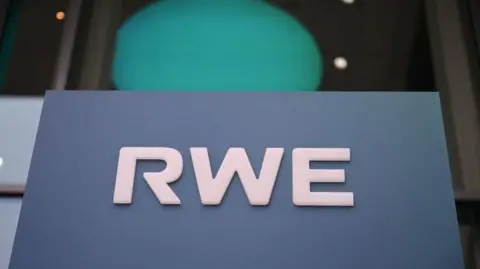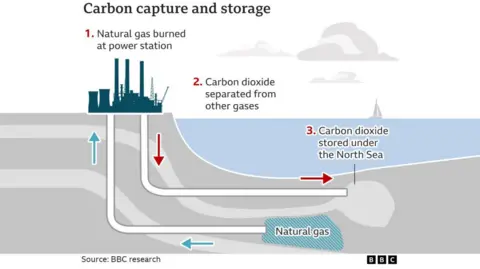Stallingborough carbon capture project outlined
 Getty Images
Getty Images- First planning documents have been filed for carbon capture project
- Around one million homes could be powered by scheme
- Power station would be in Stallingborough
- Fifty full-time jobs could be created
The first planning documents have been filed for a gas turbine and carbon capture project that could power one million homes.
The scheme would be in Stallingborough, close to the South Humber Bank Power Station, and RWE, the largest power producer in the UK, is behind it.
It could create 50 full-time operational jobs and thousands in construction and the supply chain.
Due to the size, the Secretary of State will decide whether it can go ahead.
The proposed development is expected to consist of one combined cycle gas turbine plant and to produce up to 900MW.
In such a power station, gas is combusted to drive a gas turbine, which is connected to a generator producing electricity.
Usable heat that remains in the gas turbine exhaust is passed into a heat recovery generator to make steam to create additional electricity.
Carbon emissions made from the gas burning will be captured, compressed and transported via a pipeline to about 3km below the sea bed.
It will be stored there permanently, preventing its release into the atmosphere.

The exact proposed layout of the site is to be decided, but it is approximately 36 hectares.
The main document filed with North Lincolnshire Council by RWE states a new, high voltage electrical connection will be required, as well as a natural gas pipeline.
The electrical connection will either link up to the existing National Grid Grimsby West substation, or a new substation part of the proposed Grimsby to Walpole overhead line.
RWE is a partner in the Viking Carbon Capture & Storage (CCS) scheme. This proposes a 55km onshore CO2 pipeline that would go through the Stallingborough site.
Public consultation
RWE’s preferred option is to link up the proposed power station’s CO2 emissions to that. The Viking CCS project is expected to get permission in spring 2025.
Up to two million tonnes of CO2 a year would be captured at the power station. This is the equivalent of 400,000 petrol cars.
A legally required consultation is planned for next year, when permission from the Secretary of State will be applied for.
Should permission be granted, construction could start in 2028. It would be expected to take three years to be completed.
An initial public consultation is planned in spring.
Follow BBC East Yorkshire and Lincolnshire on Facebook, Twitter, and Instagram. Send your story ideas to [email protected].
